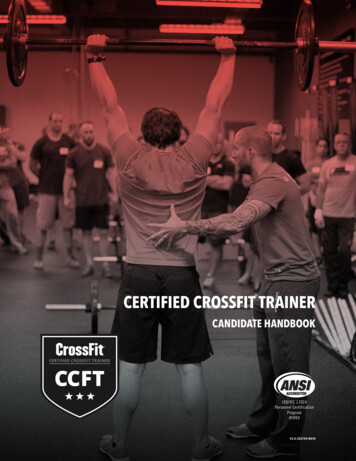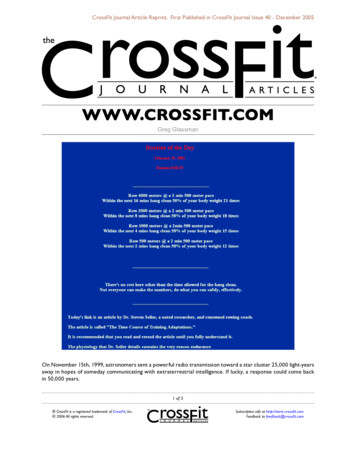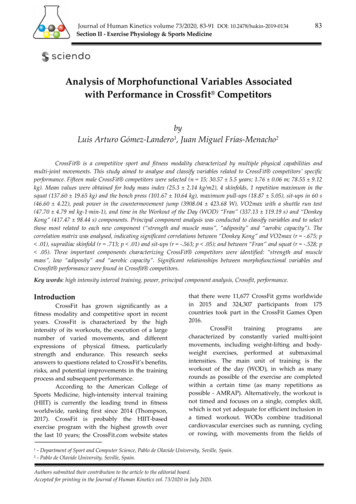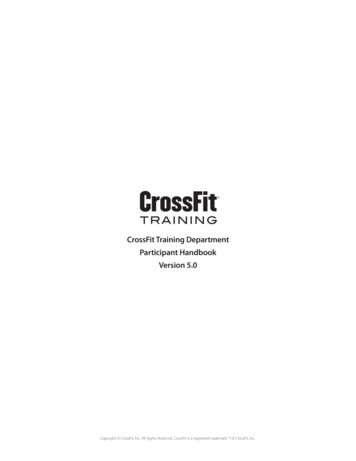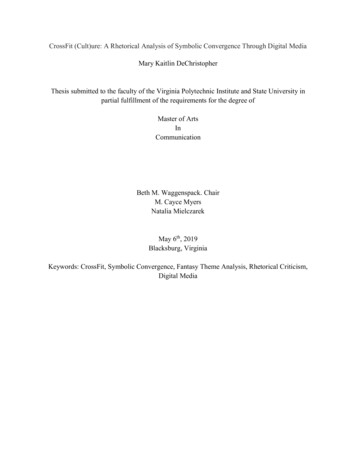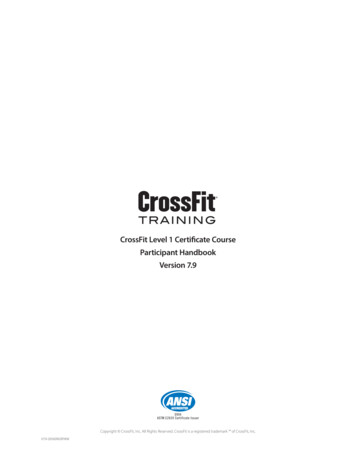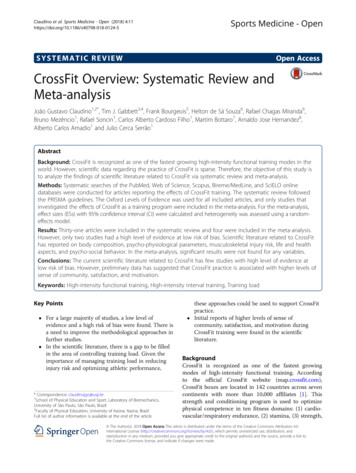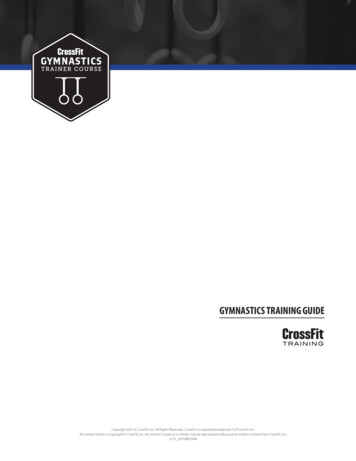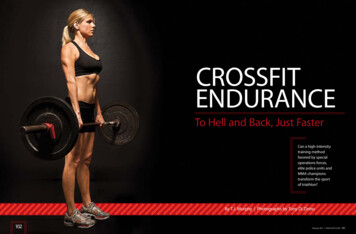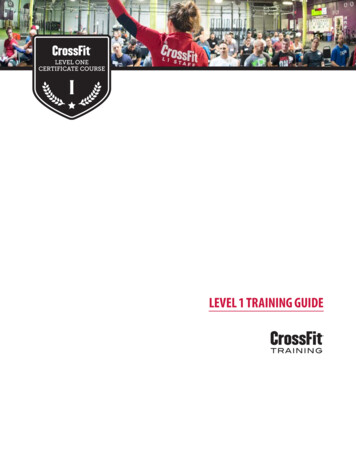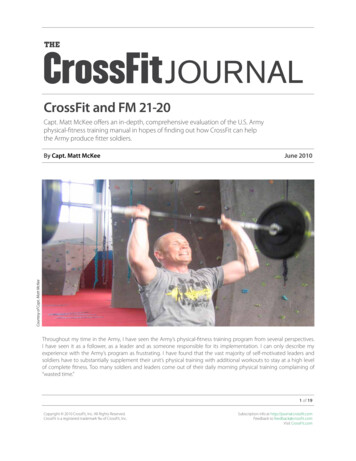
Transcription
CrossFit and FM 21-20Capt. Matt McKee offers an in-depth, comprehensive evaluation of the U.S. Armyphysical-fitness training manual in hopes of finding out how CrossFit can helpthe Army produce fitter soldiers.June 2010Courtesy of Capt. Matt McKeeBy Capt. Matt McKeeThroughout my time in the Army, I have seen the Army’s physical-fitness training program from several perspectives.I have seen it as a follower, as a leader and as someone responsible for its implementation. I can only describe myexperience with the Army’s program as frustrating. I have found that the vast majority of self-motivated leaders andsoldiers have to substantially supplement their unit’s physical training with additional workouts to stay at a high levelof complete fitness. Too many soldiers and leaders come out of their daily morning physical training complaining of“wasted time.”1 of 19Copyright 2010 CrossFit, Inc. All Rights Reserved.CrossFit is a registered trademark ‰ of CrossFit, Inc.Subscription info at http://journal.crossfit.comFeedback to feedback@crossfit.comVisit CrossFit.com
Army .(continued)ContentsAn Army special-forces team exposed me to CrossFitduring my first deployment to Iraq in 2005. However, itwas not until I was a commander of a cavalry troop (about135 men) and responsible for the unit physical-fitnessprogram that I had the understanding of CrossFit and theauthority to make substantial changes. I drew heavily onCrossFit for my unit’s physical-training program, and whilewe had successes and difficulties, I am convinced from ourexperience that the Army can use CrossFit to evolve itsphysical fitness-training program.Before I began my research for this article, I blamed the fieldmanual for Army physical-fitness training, FM 21-20, for theproblems with the program. However, while I believe FM21-20 (which has not been updated since 1992) is responsible for many of the problems, there is a broader rangeof culpability for the weaknesses in our program. CrossFitand FM 21-20 are more similar than I thought in theoreticalfoundation but are remarkably different in practice due toproblems with the manual as well as internal issues wein the Army need to resolve. Ultimately, the training ournon-commissioned officers (NCOs) receive is the onlyway to affect change in the Army. Until the Army breakswith non-functional exercises, changes the Army PhysicalFitness Test (APFT) and provides better training to our NCOcorps, we can’t evolve.Introduction . 3Part I:Foundations, Methods, & Implementation . 3FM 21-20: U.S. Army Physical-Fitness Training . 3CrossFit: Constantly Varied, High-Intensity, FunctionalMovement . 4Foundations: FM 21-20 vs. CrossFit . 6Methods: FM 21-20 vs. CrossFit . 9How the Two Programs Are Very Different .10Where FM 21-20 Falls Short .11Where CrossFit Succeeds (and What the Army Can LearnFrom It) .13Part 2:Evolution of the ArmyThrough Absorption of CrossFit .14The Use of CrossFit at the Company Level .15CrossFit and the Army .17The Final Salvo: Nutrition and the Army .17Progress .18I have tried to cut my own inroads for CrossFit into theArmy. My first step was to change my own unit’s programand convince my own soldiers about the efficacy ofCrossFit. My second step was the development of a planto purchase equipment, build obstacle courses, constructcombative pits, expand room to run/ruck-march, andchange policy at Fort Hood to make fitness morefunctional. I developed the plan at the request of the IIICorps and Fort Hood commander and command sergeantmajor. Unfortunately, the plan was not implemented. Whatfollows is the third step I have taken to encourage, inspireand request change to how we approach fitness in theArmy. CrossFit works and speaks for itself. However, I hopethis article is able to make an impact and help evolve theArmy’s physical-fitness training program.2 of 19Copyright 2010 CrossFit, Inc. All Rights Reserved.CrossFit is a registered trademark ‰ of CrossFit, Inc.Subscription info at http://journal.crossfit.comFeedback to feedback@crossfit.comVisit CrossFit.com
Army .(continued)IntroductionCrossFit’s popularity and notoriety are born out of its unique ability to make people collapse in a heap of exhaustionand sweat in a matter of minutes. By now, few in the military have not heard of CrossFit or had a personal experiencewith it.CrossFit appeals to men and women in the military for various reasons. Former athletes enjoy CrossFit because it restorescompetitiveness into their everyday lives. Challenge-seekers are never disappointed with the grueling yet relatively shortworkouts. Some people appreciate CrossFit’s ability to provide structure and direction to their workout routine, someenjoy the team-like atmosphere of group workouts, and some like the constantly varied exercises that are a welcomerelief to practitioners of monotonous routines.CrossFit is an incredibly ambitious and holistic program. It is open-source and evolves as its community of athletes andaffiliates test nutrition and exercise research to the ends of creating the optimal program. The ambition of the CrossFitcommunity creates a segment of the fitness community that flirts with the adjective “cultish.” However, CrossFit is no fad.Over 1,500 CrossFit affiliate gyms now thrive across the country, and a groundswell is lifting the conventional military(the special-operations community paved the inroads). So what does the Army need to learn from CrossFit?CrossFit and FM 21-20, the manual for U.S. Army physical-fitness training, espouse many of the same principles. However,the differences between the two programs are significant and important for the Army to consider. Through embracingand learning from the efficacy of CrossFit, the U.S. Army can close the gap between good intentions outlined in FM 21-20and effective practices. However, much to the chagrin of diehard CrossFitters and others frustrated with Army physicaltraining, CrossFit is not a panacea for the challenges leaders face in preparing their soldiers for the physical rigors ofcombat. Furthermore, even though I am personally an avid CrossFitter, a CrossFit trainer, and a troop commander whobuilt my unit’s physical-training plan around CrossFit, I do not argue for CrossFit to completely supplant the Army’sphysical-training regimen. However, the Army should use CrossFit to evolve FM 21-20 into a more effective program byincorporating many of its approaches. This article will address the similarities and differences between FM 21-20 andCrossFit, the weaknesses of FM 21-20, the strengths of CrossFit, implementation of CrossFit at the small-unit level, andhow the Army can use CrossFit as a catalyst to move the gears in the direction of better fitness and wellness.The two references used for comparison are Field Manual 21-20 (Physical Fitness Training, Change 1, Oct. 1, 1998, publishedby Headquarters, Department of the Army) and the CrossFit Level 1 Training Guide (Version 4, published by CrossFit Inc.).Part 1:Foundations, Methods and ImplementationFM 21-20: U.S. Army Physical-Fitness TrainingIn the introductory chapter to Field Manual 21-20, themanual lays out the foundations of the Army physicalfitness program, defines its terms, and explains itsPrinciples of Exercise. FM 21-20 defines fitness in a broadmanner. The manual’s components of “physical” fitness arecardiorespiratory endurance, muscular strength, muscularendurance, flexibility and body composition. The manualalso provides another list of important physical skills, called“motor” fitness. The manual explains that the elements of“motor” fitness (speed, agility, muscle power, eye-handcoordination and eye-foot coordination) are important to asoldier’s survivability in combat. The manual does not rankthe components of physical or motor fitness, as it asserts,“The Army fitness program seeks to improve or maintainall the components of physical and motor fitness .” Theinclusion of body composition in the components of fitnessimplies the necessity to control a soldier’s diet for optimalperformance. The manual then proceeds to provide theuser with guidelines for all physical-fitness programs. ThePrinciples of Exercise, according to FM 21-20, are regularity,progression, balance, variety, specificity, recovery andoverload. In the definitions of these principles, the manualadvocates a program that addresses all the fitness components (regularity), encourages good nutrition (regularity),advises adequate rest (regularity), avoids specialization(balance), includes variance, and challenges a soldier to thelimits of his capacity (progression, overload), in addition toother considerations.3 of 19Copyright 2010 CrossFit, Inc. All Rights Reserved.CrossFit is a registered trademark ‰ of CrossFit, Inc.Subscription info at http://journal.crossfit.comFeedback to feedback@crossfit.comVisit CrossFit.com
Army .(continued)The manual uses a chapter each on providing guidelinesfor cardiorespiratory, muscular-endurance, muscularstrength and flexibility training. For each type of training,the manual uses the terms frequency, intensity, time andtype (FITT) to provide a mechanism for evaluating anddeveloping training plans. In discussing cardiorespiratorytraining, FM 21-20 uses a soldier’s training heart rate (THR)as the primary measurement of intensity in such exercisebut also mentions perceived exertion as an alternatemethod. The types of cardiorespiratory exercise includerunning, rowing, biking, road-marching, swimming andothers. The manual recommends three major types oftraining for cardiorespiratory exercise: ability group, intervaland fartlek. (The manual highly discourages group pacing,such as unit formation running, for units with soldiers ofdifferent abilities.)Next, the manual broaches muscular-endurance andstrength training. The differentiation between muscularstrength and muscular-endurance training is determinedby the intensity of the exercise. In FM 21-20, intensity is thenumber of repetitions of an exercise. Muscular strength isconsidered 3-7 repetitions, muscular endurance 12-plusrepetitions, and muscular strength and endurance 8-12repetitions. The exercises for muscular-fitness trainingare vast in number and type but include everythingfrom squats, bench presses and deadlifts to biceps curls,heel raises, neck extensions and shoulder shrugs. Last,the manual addresses flexibility. Flexibility includes staticstretching, passive stretching, proprioceptive neuromuscular facilitation (PNF) stretching and ballistic stretching.The manual emphasizes the importance of a warm-up,a cool-down and stretching to increase efficiency andreduce the prospect of injury.The manual also covers body composition (a componentof its definition of fitness), nutrition, circuit training,obstacle courses, competitive fitness activities, and severalconsiderations for leaders developing a unit physicalfitness program (to include injuries and environmentaleffects). The chapter on nutrition is an elucidation of theUSDA food pyramid. The manual advocates foods rich incarbohydrates—such as pasta, rice, whole-wheat breadand potatoes—for optimal performance. The manual’sprinciples of nutrition are:1.2.3.4.Eat a variety of foods.Maintain a desirable body weight.Avoid excess dietary fat.Avoid too much sugar.5.6.7.8.Eat foods with adequate starch and fiber.Avoid too much sodium.Drink alcoholic beverages in moderation.Know the nutrition principles.The manual concludes the nutrition discussion byaddressing the importance of hydration.Circuit training receives special attention for its abilityto simultaneously challenge multiple components ofphysical and motor fitness. It is the only type of trainingpresented in the manual that can address such a broadrange of fitness components. While FM 21-20 acknowledges that unit sports can develop several types of motorfitness, it cautions the use of competitive fitness activitiesas anything but a supplement to a unit fitness-trainingplan. However, the manual makes clear the multitude ofadvantages to competitive fitness activities outside thedevelopment of physical capacity and the “tremendouspositive influence” on a unit. According to FM 21-20,competitive fitness activities “ help develop assets thatare vital to combat effectiveness. These include team spirit,the will to win, confidence, toughness, aggressiveness, andteamwork.”CrossFit: Constantly Varied, High-IntensityFunctional MovementCrossFit is a holistic approach to fitness and wellness.CrossFit aims to develop general physical preparedness(GPP) in its athletes—readiness to face the “unknown andunknowable.” In other words, CrossFit athletes strive todevelop a wide range of physical skills through constantlyvaried, high-intensity, functional movement and avoidspecializing the way a sport-specific athlete would train.CrossFit uses 10 physical skills to define fitness: cardiovascular/respiratory endurance, stamina, strength, flexibility,power, speed, coordination, agility, balance and accuracy.Using efficacy alone to measure progress, CrossFit is anevolutionary program and challenges its communityto find the solution to optimal GPP. In implementation,CrossFit harnesses competition, quantitati
Feedback to feedback@crossfit.com Visit CrossFit.com The manual uses a chapter each on providing guidelines for cardiorespiratory, muscular-endurance, muscular-strength and flexibility training. For each type of training, the manual uses the terms frequency, intensity, time and type (FITT) to provide a mechanism for evaluating andFile Size: 701KBPage Count: 19
